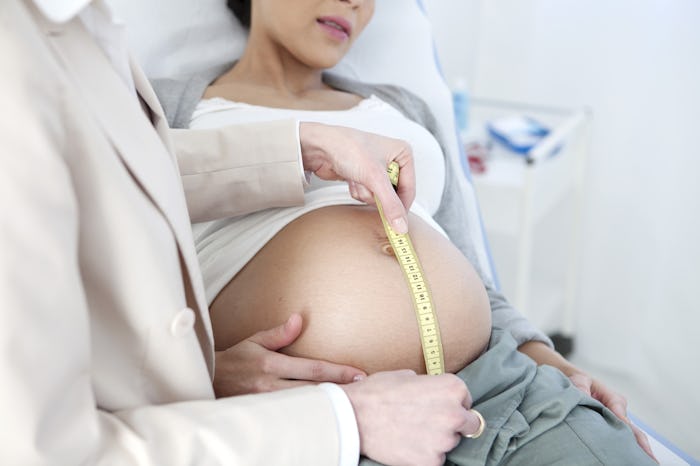Life

Here's Why Your Fundal Height During Pregnancy Is So Important
When I was pregnant, my mom marveled at the 4D ultrasound pics, repeatedly saying, "We didn't have this when I was pregnant with you." And it's true, with all the advances in modern medicine, pregnancy can feel pretty high tech these days. Yet some screening tools, like fundal height measurements, feel like they've been around for decades. So why is fundal height important, and what can a simple measuring tape tell us about fetal health?
Put simply, fundal height is determined by measuring the distance from the pubic bone to the top of the uterus, and is a tool to gauge fetal growth, according to Mayo Clinic. This measurement, done in centimeters, typically corresponds with how many weeks pregnant you are, explained Mayo Clinic. For example, if you're 20 weeks pregnant, your fundal height measurement will be approximately 20 centimeters.
However, there is actually a range that is considered normal. "Measurements between 20 weeks and 36 weeks should be within 2 centimeters of the weeks of gestation," explained Elizabeth Stein, C.N.M., M.S.N., M.P.H., a midwife in New York City and the founder of askyourmidwife.com, in an interview with Fit Pregnancy. "For example, at 32 weeks pregnant, the range of normal for fundal height is 30 to 34 centimeters. Any measurement larger or smaller should be a red flag that needs further evaluation."
So, if your fundal height is off, should you be panicking? The answer is, it depends. First and foremost, the accuracy of the test varies, and can be affected by your weight, if you have a history of fibroids, or if you're carrying multiples, according to Mayo Clinic. "It's subjective at best and most accurate when done by the same person at every visit," said Stein speaking to Fit Pregnancy.
Additionally, some explanations for measuring "large" are entirely benign, according to Baby Center, which cited an incorrect due date, obesity, and loose abdominal muscles as possible culprits. What's more, your fundal height measurement can also be affected by the way you or your baby is positioned. "It could be how baby is situated in utero — they could be laying toward the front or back. Spinal alignment can also make a huge difference and chiropractic adjustment can change appearance of bump," explained Ashlyn Biedbach, a doula in Denton, Texas, speaking to Romper for a previous article.
However, if your fundal height measurement is outside the normal range (either too smaller or too big), your obstetrician or midwife will most likely order an ultrasound to confirm your due date and rule out potential problems like intrauterine growth restriction and too little amniotic fluid, according to Baby Center.
If you're convinced that your due date is entirely wrong, it's worth noting that in one study, the variation in fundal height predictions was robust, ranging from 13.1-15.5 days, and for obese pregnant women, that range was even more pronounced at 17.9 to 23.3 days, according to OBG Project, reporting on a study in BJOG, International Journal of Obstetrics and Gynecology.
Interestingly, while fundal height measurements are an important screening tool, they certainly aren't the only one. In fact, in a study published in AJOG, American Journal of Obstetrics and Gynecology, the use of handheld ultrasound–measured fetal abdominal circumference (HHAC) was found to be more accurate than fundal height measurements for screening for fetal growth restrictions. If you find yourself in the situation where you are doubting the accuracy of our test results, it can't hurt to get a second opinion.